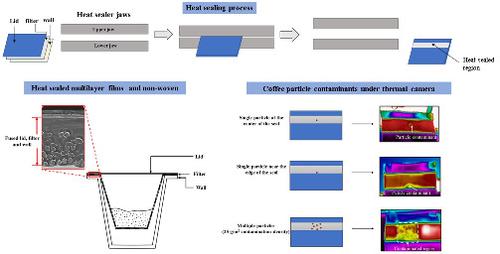当前位置:
X-MOL 学术
›
Packag. Technol. Sci.
›
论文详情
Our official English website, www.x-mol.net, welcomes your
feedback! (Note: you will need to create a separate account there.)
Effect of heat-sealing parameters on the thermal profile and seal strength of multilayer films and non-woven
Packaging Technology and Science ( IF 2.8 ) Pub Date : 2021-07-01 , DOI: 10.1002/pts.2600 Divya Ponnambalam 1 , Loong Tak Lim 2 , Annamalai Manickavasagan 1 , Fu Yucheng 3
Packaging Technology and Science ( IF 2.8 ) Pub Date : 2021-07-01 , DOI: 10.1002/pts.2600 Divya Ponnambalam 1 , Loong Tak Lim 2 , Annamalai Manickavasagan 1 , Fu Yucheng 3
Affiliation

|
Heat sealing is one of the most common techniques for sealing food packages. In this study, the effects of sealer parameters such as dwell time (0.5–2 s), jaw temperature (225–250°C) and pressure (69–345 KPa) and the seal contaminants (coffee particles [0.70–0.85 mm]) were studied on polymer materials used in coffee capsules: (1) lidding, poly(ethylene terephthalate) (PET)/Al/linear low-density poly(ethylene) (LLDPE); (2) wall, polystyrene (PS)/ethylene-vinyl alcohol copolymer (EVOH)/PS; and non-woven filter, NW1 (mono-component fibre) or NW2 (bicomponent fibre [core/sheath]). The presence of NW1 and NW2 non-woven in the seal structures decreased the interfacial temperature by 5°C and 11°C, respectively in comparison to seal structures without non-woven. The degradation of the seal bonding caused a decline in the seal strength at elevated temperature (NW: >240°C without NW: >235°C) and longer dwell time (NW: >1 s, without NW: >1.5 s). The core and sheath structure of NW2 (969 N/mm) was responsible for higher seal strength in comparison to NW1 and without NW, as the core remained intact during the sealing, increasing the material strength. The minimum pressure of 207 KPa was required for creating enough contact between films to achieve proper sealing. The coffee particles buried under the opaque layer of lidding films created visible thermal artefacts when observed under thermal camera. The contaminated region differed by 30–38°C from the surrounding sound region after cooling for 3.5 s. The seal strength was stronger when a single coffee particle was in the middle compared to a sample with multiple particles.
中文翻译:

热封参数对多层薄膜和无纺布的热分布和密封强度的影响
热封是密封食品包装最常用的技术之一。在本研究中,密封剂参数的影响,例如停留时间 (0.5–2 s)、钳口温度 (225–250°C) 和压力 (69–345 KPa) 以及密封污染物(咖啡颗粒 [0.70–0.85 mm]) ) 对用于咖啡胶囊的聚合物材料进行了研究:(1) 封盖,聚对苯二甲酸乙二醇酯 (PET)/Al/线性低密度聚 (LLDPE);(2)墙体,聚苯乙烯(PS)/乙烯-乙烯醇共聚物(EVOH)/PS;和无纺布过滤器,NW1(单组分纤维)或 NW2(双组分纤维 [芯/鞘])。与没有无纺布的密封结构相比,密封结构中 NW1 和 NW2 无纺布的存在使界面温度分别降低了 5°C 和 11°C。密封粘合的退化导致密封强度在升高的温度(NW:>240°C,无 NW:>235°C)和更长的停留时间(NW:>1 s,无 NW:>1.5 s)下下降。与 NW1 和没有 NW 的情况相比,NW2 的芯和鞘结构 (969 N/mm) 具有更高的密封强度,因为在密封过程中芯保持完整,增加了材料强度。需要 207 KPa 的最小压力才能在薄膜之间产生足够的接触以实现适当的密封。当在热像仪下观察时,埋在不透明盖膜层下的咖啡颗粒会产生可见的热伪影。冷却 3.5 秒后,污染区域与周围声音区域相差 30-38°C。
更新日期:2021-09-01
中文翻译:

热封参数对多层薄膜和无纺布的热分布和密封强度的影响
热封是密封食品包装最常用的技术之一。在本研究中,密封剂参数的影响,例如停留时间 (0.5–2 s)、钳口温度 (225–250°C) 和压力 (69–345 KPa) 以及密封污染物(咖啡颗粒 [0.70–0.85 mm]) ) 对用于咖啡胶囊的聚合物材料进行了研究:(1) 封盖,聚对苯二甲酸乙二醇酯 (PET)/Al/线性低密度聚 (LLDPE);(2)墙体,聚苯乙烯(PS)/乙烯-乙烯醇共聚物(EVOH)/PS;和无纺布过滤器,NW1(单组分纤维)或 NW2(双组分纤维 [芯/鞘])。与没有无纺布的密封结构相比,密封结构中 NW1 和 NW2 无纺布的存在使界面温度分别降低了 5°C 和 11°C。密封粘合的退化导致密封强度在升高的温度(NW:>240°C,无 NW:>235°C)和更长的停留时间(NW:>1 s,无 NW:>1.5 s)下下降。与 NW1 和没有 NW 的情况相比,NW2 的芯和鞘结构 (969 N/mm) 具有更高的密封强度,因为在密封过程中芯保持完整,增加了材料强度。需要 207 KPa 的最小压力才能在薄膜之间产生足够的接触以实现适当的密封。当在热像仪下观察时,埋在不透明盖膜层下的咖啡颗粒会产生可见的热伪影。冷却 3.5 秒后,污染区域与周围声音区域相差 30-38°C。











































 京公网安备 11010802027423号
京公网安备 11010802027423号